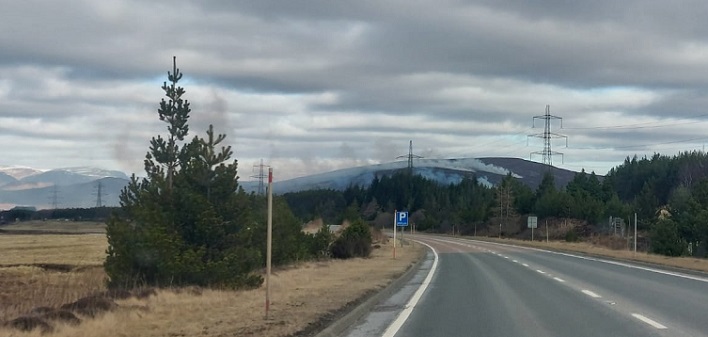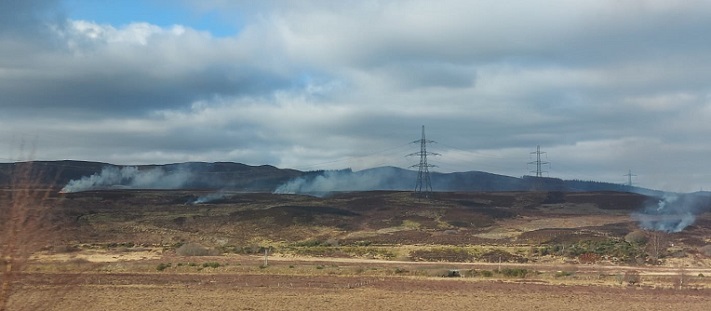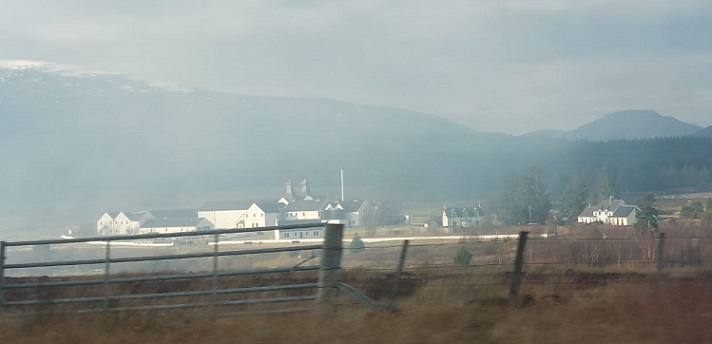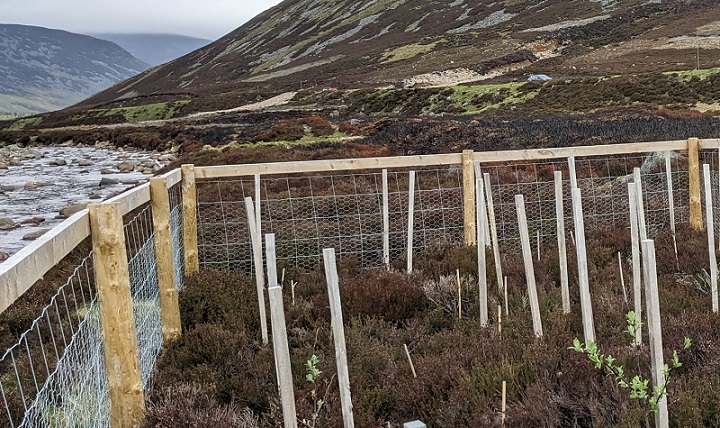
With little sign of the Scottish Government implementing the provisions of the Wildlife Management and Muirburn (Scotland) Act 2024 and while the Cairngorms were aflame from muirburn (see here), the Cairngorms National Park Authority (CNPA) Board on 14th February approved new fire management byelaws and a draft “Integrated Wildfire Management Plan” for consultation with land managers for the National Park (see here for papers and here for a video of the meeting).

According to the news release launching the consultation (see here) “Land managers” – the very people who set large parts of the Cairngorms alight each year – “are being invited to give their views on a detailed plan to tackle wildfire risk across the Cairngorms National Park.”
Meantime, the “plans for a seasonal fire management byelaw covering the National Park” – which will affect the public but not land managers – “are being submitted to Scottish ministers after the formal wording was approved by Park Authority board members.”
Both initiatives originate in the Cairngorms National Park Partnership Plan 2022-27 which had a section on fire management and committed to:

The fire bye-laws
During the very dry Spring of 2023, during which much of BrewDog’s Lost Forest died (see here) , local people – particularly around Glenmore – rightly expressed serious concerns about the risks from fires lighted by visitors – and called for action. There were two main aspect to these concerns, first the risk to housing/people and second the risk to native woodland. The two issues are interrelated on Strath Spey, from the Aviemore area and to the north. This is because a significant proportion of housing is located in and around pine woods. There is California type potential for combustion and destruction which is increased because this is the main honeypot for visitors in the National Park and it only takes one person to throw a lighted cigarette out of a car window………….
The CNPA’s initial response at their Board Meeting in June 2023, where the issue was discussed at length, was reasonably proportionate with the Chief Executive Grant Moir warning that byelaws were not a magic solution. That position, however, fairly rapidly evolved into a proposal to try and ban all recreational fires, including barbecues, for six months of the year through the use of byelaws. That was fuelled by public consultation which showed high levels of support, among both visitors and local residents, for such measures.
Unfortunately, from the start the CNPA treated muirburn as a completely different issue to recreational fires and something to be addressed by the Scottish Government. This drastically restricted the parameters of the debate and the public were never asked, for example, what they thought about smoke from muirburn polluting the air above the A9 or settlements in the National Park:

Had they been given the opportunity, I suspect the responses from the general public would have shown they are as concerned about the risks from muirburn as they are from recreational fires, particularly if they had been presented with the facts: the most serious fire incident in the National Park that I know of in the last ten years took place in Glen Tanar and was caused by the landowner (see here).
Once the CNPA had decided to adopt byelaws early last year, there was another consultation in the Autumn on the wording. As a result of this, as explained in the board papers last week, proposals for the byelaws to cover fires in private gardens and for provisions that would have prevented landowners from consent to fires on their land EVEN at times of very high fire risk (which is what happened in Glen Tanar) have been removed. This means that the scope of the byelaws has now been limited to removing the right to light a fire from access rights for six months of the year.
My own view is this is not reasonable or proportionate. There is no justification for banning barbecues for example from areas which landowners are allowed to burn regularly outside of very dry periods. However, if Scottish Ministers do believe such controls are justified, they need to explain why just the Cairngorms? Why not all of Scotland? In which case it would be much more effective and efficient for the Scottish Government to amend the Land Reform (Scotland) Act 2003 rather than individual access authorities introducing byelaws.
It would be even better and fairer, however, to implement a national system for controlling recreational fires in high risk places, like woodland and around houses, but then only apply these controls in other places during high risk periods.
Meantime, the CNPA hopes the £500 fines for breaching the provisions of the byelaws will come into force by June. By contrast, the Scottish Government has given no date for when the fines of up to £40,000 for breach of the muirburn code will come into effect nor given any indication of how the provisions of the muirburn licensing scheme, which would help prevent all that smoke over the A9 causing respiratory disease, might be enforced.
The draft Integrated Wildfire Management Plan
Wildfires, in the sense of a fire that is burning rapidly and out of control, can have both natural and human causes. Natural fires, caused by lightning, have an important role in the ecology of pinewoods, enabling them to regenerate more easily and helps create their varied structure which is so valuable to nature. For example, experiments at Abernethy have shown that fire promotes blaeberry, a key food source for capercaillie, on the forest floor [see Chapter 4, Fire, in Abernethy Forest by Ron Summers]. The Cairngorms National Park will need some natural fires if the large native woodland plantations funded by Scottish Forestry at places like Muckrach, Far Ralia and Kinrara are to have any ecological value.
Trees, particularly dead trees, play a key role in enabling natural fires as they combust when hit by lightning in a way that heather for example doesn’t. While natural forest fires may spread onto surrounding moorland, helping the forest to expand, the ecological impact of this is completely different to repeated muirburn which prevents woodland succession and reduces biodiversity in favour of red grouse.
Natural forest fires, however, while ecologically beneficial in a way that muirburn isn’t, also affect economic interests, particularly the timber industry but now the native woodland plantations being traded under the Woodland Carbon Code, as well as human settlements. We therefore put them out, generally very successfully. The incidence of natural fires has also been shown to vary over time, according to climate. With warmer drier summers predicted the risk from both natural fires – most lightning strikes happen over the summer months – and from human caused fires is likely to increase.
Those increased risks, coupled with the increased fuel load caused by native woodland planting, are the justification for the CNPA’s draft Wildfire Management Plan. Instead, however, of founding the plan on basic ecological principles – which we should expect in a National Park – the CNPA assumes the status quo and that it is acceptable for grouse moor owners to burn large parts of the National Park each year. Indeed, the plan goes a step further than that and attempts to harness the resources sporting estates devote to muirburn to putting out wildfires (including those caused by muirburn getting out of control!).
In doing so, the CNPA is helping to legitimise muirburn in the National Park. This helps explain why so many sporting estates have been happy to help draft the document. As an added sweetener, the CNPA has for the last year been awarding estates capital grants from the Climate Adaptation fund to buy fire fighting equipment. So far the CNPA has not published who has received such grants but it will be interesting to see if any have been used to subsidise grouse moor owners.
There is no doubt that currently gamekeepers, the people with expertise in muirburn, provide an important resource for tackling wildfires. I have talked to people about the wildfire at Cannich. It was initially caused by campers, who did the right thing and reported it, but it was then not properly put out by the Scottish Fire and Rescue Service and continued to burn unseen. The result was it later got completely out of control and was only stopped because gamekeepers used their skills to burn a strip ahead of the advancing fire and stopping its spread. The challenge is that if the number of intensively managed grouse moors reduce – which is what needs to happen if the CNPA is to tackle the nature and climate emergencies – those skills are going to reduce unless our public authorities take action to remedy that.
The draft plan, which the CNPA news release describes as “pioneering”, contains no proposals to address this challenge but instead is entirely reliant on intensive grouse moor management and muirburn continuing:
“The Integrated Wildfire Management Plan recognises that the Cairngorms National Park is already blessed with a workforce on estates which are skilled, practiced and equipped to fight fires. It is vital that those skills and resources are maintained in the years ahead, to ensure all land holdings reach a high standard in terms of wildfire prevention and preparedness”.
And:
“Many estate staff are well practised and equipped to fight wildfires. This is particularly the case on estates where muirburn is regularly practiced. People who regularly conduct muirburn understand fire behaviour and are practiced in firefighting techniques. They understand the equipment which is necessary to fight a fire, and this equipment is maintained and used regularly. It is vital these skills are retained in the National Park, and there is continued investment in equipment.”
Here we have a good example of what is supposed to be a National Park attempting to sanctify intensive grouse moor management! Nevertheless, it is still a difficult juggling act, trying to harness the resources of intensively managed grouse moors to fight wildfires to enable woodland expansion to continue:
“The long-established culture of providing mutual firefighting aid to neighbours is threatened by the current polarisation across many land management issues. Some who see muirburn as crucial to their land management have expressed reluctance to fight fires on land that is managed in a manner which increases fuel loads. Currently many estates provide SFRS [Scottish Fire and Rescue Service] with manpower and equipment when wildfires occur even when a long way from their own land. Reluctance has recently been expressed about continuing to offer this service when legislation is perceived as being hostile to muirburn.”
A further consequence of the CNPA trying to keep grouse moor owners and estate staff happy is that the plan contains no proposals that would help protect trees from muirburn that gets out of control, for example recommending buffer zones around woodland planting.

In fact, while there is a discussion in the plan about need for firebreaks, the draft Fire Management Plan contains no measures to reduce the risk of wildfires that would require a change in how land in the National Park is currently managed or used. Instead, it focusses on how to harnesses the resources of gamekeepers to fight fires that get out of control.
Discussion at the CNPA Board Meeting did reveal that Scottish Forestry are considering changes to the Scottish Forestry Grants system that would require new native woodland plantations to incorporate fire break. Unfortunately it wasn’t clear whether the CNPA has pointed out to Scottish Forestry that natural regeneration of woodland would be a far more effective way of addressing the problem of increased fuel loads caused by planting thousands of trees all at the same time behind deer fences. This is because natural regeneration creates a far more varied forest structure while continued grazing suppresses the build up of rank vegetation below the trees. While planted trees eventually shade out that ground vegetation and in the case of Scots Pine become large enough to resist most fires, reducing the fire risk, for a time those risks in plantations are very high.
Nor is there any commitment in the plan for the CNPA to change its approach to new developments to take account of wildfire risk. Why, when flood risk every has to be considered as part of planning application, are there no proposals to prevent new housing developments in woodland? Mike Davis’ book, the Ecology of Fear (1999) contains a brilliant chapter “The Case for Letting Malibu burn”. While the book was about California, which has a very different in ecology and climate to Scotland, what it was effectively arguing was that we should be leaving some places to nature – with fire risk providing one example of why we should do that.
While some of the CNPA’s staff clearly understand ecological principles, unfortunately they are not allowed to apply them in the National Park. The CNPA’s news release about the fire management plan rightly states:
“Wildfires release carbon, can damage or destroy sensitive and rare habitats, can kill species and pose a significant threat to people and property. Climate change impacts, including rising temperatures and drier summers, have increased wildfire risk. Major incidents at Cannich and Daviot in the Highlands in June 2023 brought this into sharp focus.”
This understanding, however, is only being applied selectively. Muirburn, which even when properly controlled, contributes far more to the release of carbon, destruction of habitats etc in the National Park is completely off the agenda. last week. The CNPA’s hypocritical and contradictory approach to fires, which I described three years ago (see here) shows no signs of changing. In their discussion at the Board Meeting last week not a single CNPA board member questioned what they are doing or the implications for a National Park which has a legal duty to put nature first.

Is there another country where a cadre of foreigners burns the landscape so the they can play at hunting? Of course there was Kenya and India. And Ireland.
Fire Management Byelaws
The proposed Fire Management Byelaws are, in my opinion, a waste of time and public money. The Scottish Outdoor Access Code (SOAC) is not law but the detailed guidance in the Code should help to ensure that few problems arise interpreting the Land Reform (Scotland) Act 2003. SOAC states that campfires should not be lit in woods or on peat which is much of the CNP.
We are in a situation where there are not enough resources to manage our land under the Act. Rangers do not have the numbers to cover the National Park now. If campfires are banned under a byelaw, I suggest nothing will change.